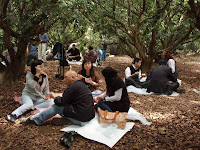

In early morning, people will transport the food, paper offerings, basins, cooking utensils, and other ingredients across long distances, and a fire will be built at a yard near the gravesite. During the worship, they will clean the graves of dust and debris, burn joysticks and paper offerings, and present wine and a variety of food as well as a whole pig to their ancestors and that does not go to waste. After the rites are held, the pig will be chopped and cooked, and a delicious refreshment of Poon Choi will be served at about 12:00pm. Nowadays, this custom is seldom practiced, and people in the New Territories usually have Poon Choi at their ancestor hall during religious rituals, festivals, special occasions and wedding banquets. Poon Choi can also be enjoyed at many restaurants throughout the year.


This spring, the Tang’s families visit their ancestral graves on 31 March 2009. The culinary custom is also called “Chi Shan Tou” which means to eat Poon Choi at the hillside. Unlike the regular Poon Choi, the one prepared for this grave-sweeping festival is only composed of 4 layers of ingredients such as bamboo shoot, bean curd, squid, and braised pork in soy-sauce paste. Through stir frying, braising, and stewing, the cooks prepare each ingredient separately with a big wok heated with firewood. After cooking, the ingredients are put into the buckets for later use. People start gathering in the yard at noon and watch the cooks placing each ingredient in basins which are now made of metal instead of wood. More than 40 basins of Poon Choi are served. However, because of large amount of food provided in one portion, people can hardly finish the whole basin, and usually bring the remaining food home.
The Tang’s families from Pang Shan follow this traditional custom and culture for generations. It forms a bond between families, and the younger people learn their origins and to respect their ancestors. People carry out the memorial ceremony in a picnic-like atmosphere which shows a time for happy communion with ancestors rather than a somber occasion.
Poon Choi: Big Bowl Banquet (South China Morning Post) - http://blip.tv/file/715209
 It is said that firewood will add a unique flavor and allow better control over the cooking temperature.
It is said that firewood will add a unique flavor and allow better control over the cooking temperature.A) Poon Choi Cooking:
1 & 2. Pork; 3 & 4. Rice;
5 & 6. Bamboo shoot; 7 & 8. Bean curd;
9 & 10. Secret recipe; 11 & 12. Squid;
13 & 14. Buckets and basins;
26. Rice is a good complement to Poon Choi.
27 & 28. Please take your basin.
29 & 30. Happy gathering.




















































